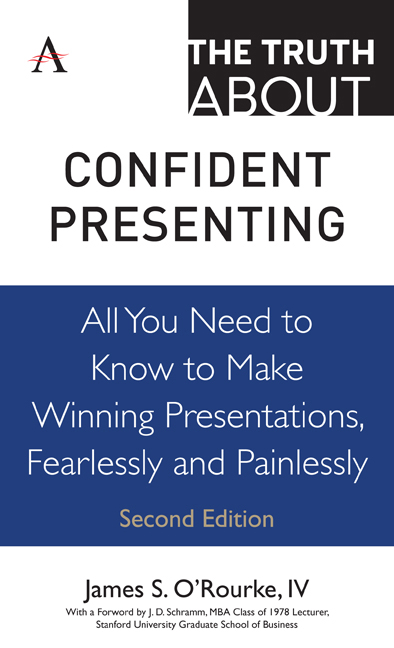 The Truth about Confident Presenting
The Truth about Confident Presenting Book contents
- Frontmatter
- Contents
- Foreword
- Introduction
- Part I Some Initial Truths
- Part II The Truth About Getting Ready to Speak
- Truth 7 Talk is the work
- Truth 8 Know what your audience is looking for
- Truth 9 There is a difference between speaking and writing
- Truth 10 Preparing a presentation is a relatively simple process
- Truth 11 Begin by analyzing your audience
- Truth 12 Know your audience
- Part III The Truth About What Makes People Listen
- Part IV The Truth About Developing Support for Your Presentation
- Part V The Truth About Getting Up to Speak
- Part VI The Truth About Managing Anxiety
- Part VII The Truth About Nonverbal Communication
- Part VIII The Truth About Visual Aids
- Part IX The Truth About Handling an Audience
- Part X The Truth About What Makes a Presentation Work
- References
- Acknowledgments
- About the Author
Truth 9 - There is a difference between speaking and writing
from Part II - The Truth About Getting Ready to Speak
- Frontmatter
- Contents
- Foreword
- Introduction
- Part I Some Initial Truths
- Part II The Truth About Getting Ready to Speak
- Truth 7 Talk is the work
- Truth 8 Know what your audience is looking for
- Truth 9 There is a difference between speaking and writing
- Truth 10 Preparing a presentation is a relatively simple process
- Truth 11 Begin by analyzing your audience
- Truth 12 Know your audience
- Part III The Truth About What Makes People Listen
- Part IV The Truth About Developing Support for Your Presentation
- Part V The Truth About Getting Up to Speak
- Part VI The Truth About Managing Anxiety
- Part VII The Truth About Nonverbal Communication
- Part VIII The Truth About Visual Aids
- Part IX The Truth About Handling an Audience
- Part X The Truth About What Makes a Presentation Work
- References
- Acknowledgments
- About the Author
Summary
Before you decide to gather people in one room and speak to them, consider whether you really need to give a presentation. Alternative communication channels may be more useful, productive and efficient. They may be less expensive, as well.
Think for a minute about the essential differences between speaking and writing. Writing produces a permanent record and can be used to convey great detail. It's often much more precise than a spoken presentation, and can be used to carefully control wording. Speaking, on the other hand, produces a richer context, including nonverbal cues. It seems less rigid, less permanent and may be more effective.
If you're planning to gather a group of employees to hear about the implementation of a new business strategy, then a speech may be a good idea, but only if they have enough information to understand what you're about to say, and if personal contact with the audience will advance both the speaker's and the listeners’ goals. A speech is certainly more expensive than an e-mail or a memo. Just divide the monthly compensation by the number of hours worked times the number of people in the room, and then add the costs in lost productivity and opportunity. Be sure to calculate transportation, room-use costs, refreshments and other incidentals, as well. The cost of a presentation can quickly add up to much more than another communication channel will cost.
Writing in the form of a memo, letter, report or proposal may be more efficient, cheaper and more effective than a presentation, depending on the needs of the audience. How will they take in and process the information you're passing to them? Will they need high levels of detail or tabular data to understand your key points? Will they require charts, graphs and illustrations? Will they want to read at their own pace and convenience and then return to the information for later reference?
A written document can take on a life of its own and is certainly more permanent than the spoken word. The choice you make depends on the needs of your audience and, frequently, the customs and culture of the organization you're working with.
Information
- Type
- Chapter
- Information
- The Truth about Confident PresentingAll You Need To Know To Make Winning Presentations, Fearlessly And Painlessly, pp. 33 - 36Publisher: Anthem PressPrint publication year: 2019